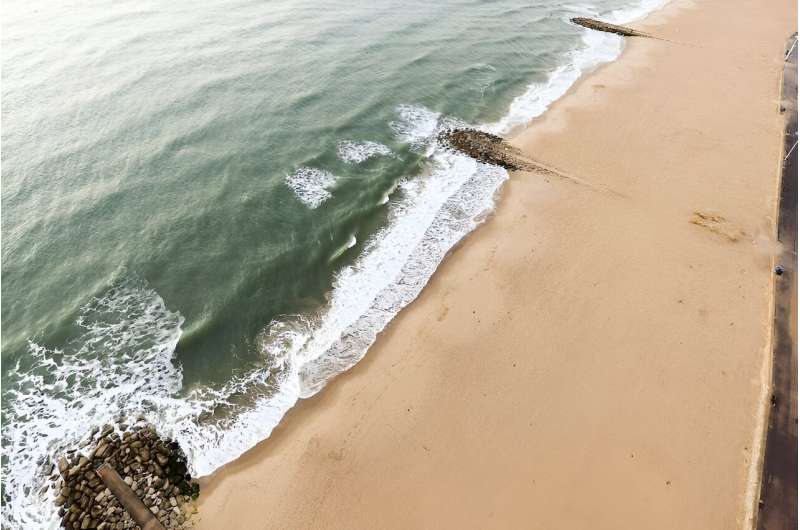Coastlines—the interface between land and sea—lie at the frontline in the battle against climate change impacts.
Globally, almost 1 billion people now live within 10km of a coastline and the same number live in areas less than 10 meters above sea level. These populations face some of the world’s biggest climate hazards, such as coastal floods from rising sea levels and the effects of hurricanes and tropical storms, which are becoming more frequent and deadly.
If there is a 2 meter increase in sea levels by 2100, this may lead to the forced migration of between 72 million and 187 million people.
However, coastlines vary substantially in their physical properties, and are found across all latitudes, environments and with a range of ecosystems and types of human activity. This means that coastline responses to climate change will vary from one place to another.
Several studies have identified sandy coastlines as particularly vulnerable to climate change, because they are made up of loose sand grains that are easily eroded by waves. A survey in 2018 showed that 24% of sandy coasts globally were already experiencing persistent net erosion because of climate change, and this was projected to get even worse in the future.
This is of concern because sandy coasts are particularly important for biodiversity, carbon storage, agriculture and tourism.
In a recent study of South African coastlines I examined the properties that contribute to their physical and biological resilience. Coastal landforms (features like estuaries, barrier islands, beaches and sand dunes) can buffer the effects of climate change and provide ecosystem and environmental services. Viewing coastal landforms as “green infrastructure” is a way to work with nature to manage the impacts of climate change.
Regenerating coastlines to boost resilience
Not all sandy coastlines respond in the same ways to climate, in part because they are made up of different landforms. Research shows that these landforms respond in different ways to waves, tides, sea-level change and sediment supply.
Their varied behaviors mean that a range of management responses are required to limit the impacts of climate change on these landforms, and this is the challenge facing all coasts globally in the 21st century.
However, there are some problems. Many management approaches used in the past are inappropriate or have actually made the situation worse. A classic example is where a sea wall or revetment is built along an eroding sandy coastline. This is usually a hard, high, straight structure, often built of concrete and designed to stabilize the coastline and keep the sea out.
These structures often focus rather than disperse incoming wave energy, leading to increased beach erosion and undercutting of the sea wall, and requiring further and bigger structures to be built as the coast erodes even faster. Many such engineering structures designed to protect coasts are expensive, require continuous maintenance, and may have similar unintended consequences. Thus, these structures often make coastal problems worse, not better.
Instead, different approaches are needed. Working with—and not against—the natural processes and landforms that already exist along sandy coastlines may be a more effective and cheaper option. This is where natural beaches or sand dunes may protect the land against coastal erosion and be maintained by natural ecological and sedimentary processes.
In my study, I have shown how the natural landforms of different coastal environments can serve as green infrastructure: natural features that perform the same function as hard engineering structures in coastal protection. Natural beaches or sand dunes can stabilize the land surface and reduce erosion rates, provide ecosystem services and maintain biodiversity, store organic carbon, modify microclimate, and reduce the impacts of coastal hazards on local communities.
However, this approach has not been commonly used along African coasts, despite its environmental benefits.
Using coastal landforms as green infrastructure can build coastal resilience to climate change. This is a “win-win” situation for both coastal landforms and populations.
Restoring green infrastructure
Green infrastructure is part of wider nature-based solutions to addressing environmental issues and climate change impacts. However, a number of developments are needed to make the use of green infrastructure a wider practice, but local authorities, planners and managers.
Coastlines need to be recognized as naturally dynamic, shifting environments rather than as environments that need to be controlled and managed. The multiple and varied benefits that coastlines give to the environment, ecosystems and people must be recognized, including how they relate to one another.
Coastlines therefore need to be considered as integrated and dynamic systems, not simply as the boundaries between land and sea.
And finally, not all coastlines are the same—sandy and rocky coastlines work in different ways, as do coral reef, mangrove or glaciated coasts. This means that each coastline has different elements that contribute to their overall resilience or vulnerability to climate change impacts.
Photo is provided via Wikimedia Commons.
This article by Daniel Merino is republished (with minor edits) from The Conversation under a Creative Commons license.

